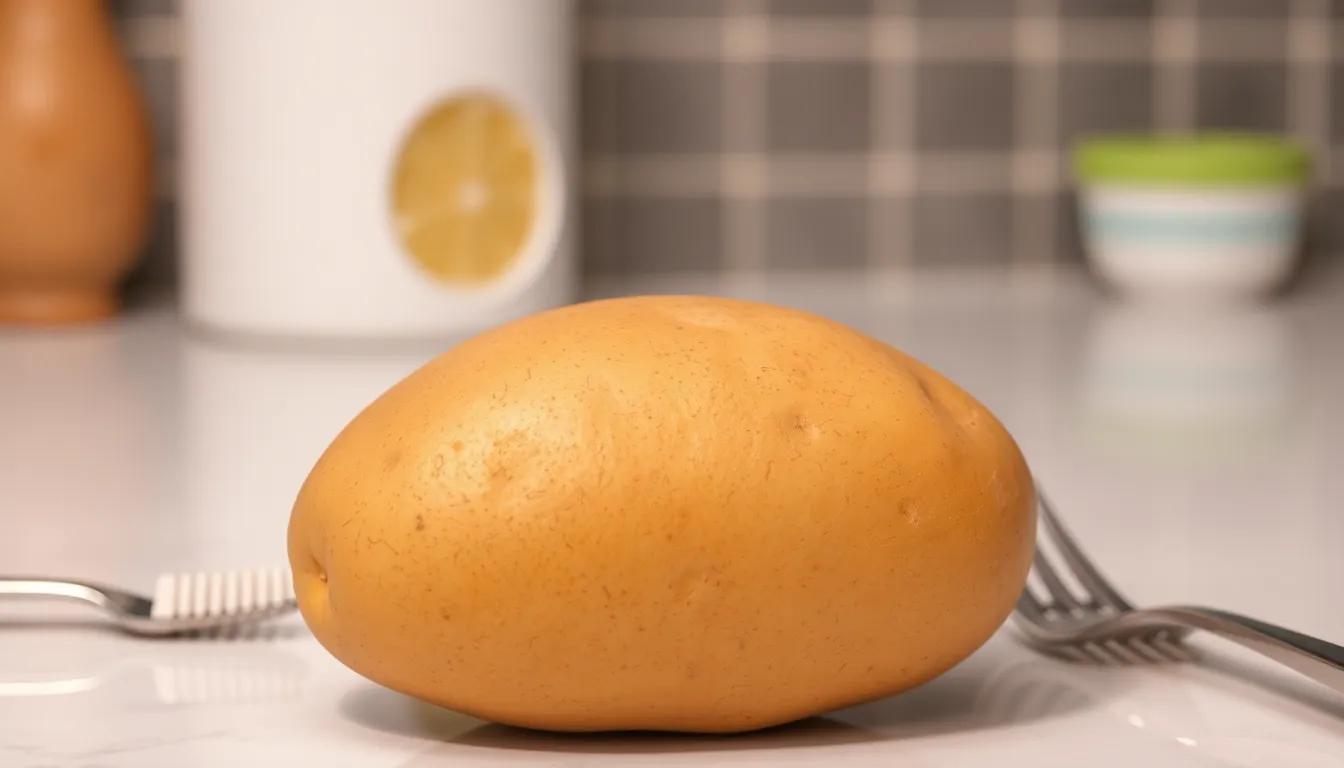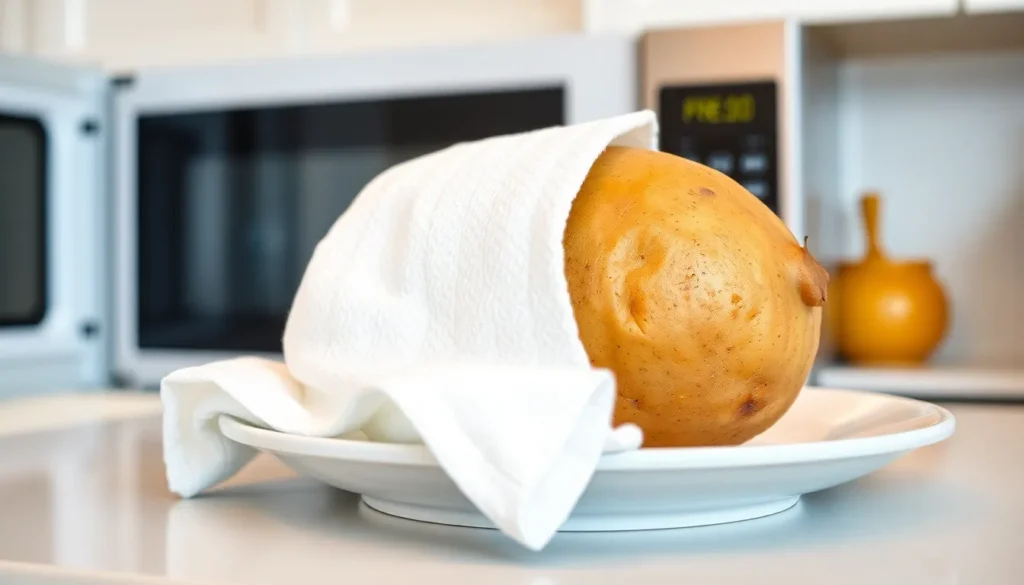Table of Contents
ToggleMicrowaving a potato might seem like a simple task, but it can feel like a culinary game of roulette. One minute too long and you’ve got a sad, shriveled mess; too short and you’re left with a crunchy disappointment. Fear not, aspiring spud chefs! Unlocking the secret to perfectly cooked microwaved potatoes is easier than you think.
Understanding Microwave Cooking
Microwave cooking uses high-frequency electromagnetic waves to heat food quickly. Energy penetrates the potato, exciting water molecules, which generates heat. This method significantly reduces cooking time compared to conventional methods.
Timing is crucial when microwaving potatoes. A medium-sized potato typically requires 5 to 10 minutes, depending on its size and the microwave’s wattage. Starting with shorter intervals and checking for doneness prevents overcooking.
Covering the potato with a damp paper towel or microwave-safe lid enhances steam circulation, promoting even cooking. Poking holes in the skin allows steam to escape, preventing potential bursting during cooking.
Power settings also play a role in the cooking process. Using a lower power setting, around 50%, can produce a more evenly cooked potato by slowing down the cooking process, allowing for more thorough heat distribution.
Microwave-safe containers are essential for safety. Some materials, like metal or non-microwave-safe plastic, can cause sparks and melting. Using glass or ceramic containers ensures safe heating without adverse reactions.
After cooking, letting the potato rest for a few minutes allows residual heat to finish the cooking process. Checking the texture with a fork determines if it reaches the desired doneness. A properly cooked potato should feel tender and soft without cold spots.
Preparing the Potato

Preparing a potato involves careful selection and cleaning processes, ensuring optimal results when microwaved. These steps set the foundation for perfectly cooked potatoes.
Selecting the Right Potato
Choosing the right potato enhances microwave cooking. Medium-sized russet potatoes work well; they provide a fluffy texture when cooked. Yukon gold and red potatoes also perform nicely, adding creamy richness. Inspect the skin for blemishes or soft spots, which indicate a lack of freshness. Select potatoes that feel firm and heavy for their size. Uniformity in size among selected potatoes promotes even cooking, reducing the chances of inconsistencies.
Cleaning and Pricking the Potato
Cleaning the potato removes dirt and potential contaminants. Rinse it under cold running water and scrub the skin gently with a vegetable brush. This process ensures all debris is cleared away. After cleaning, using a fork to prick the skin prevents bursting during microwaving. Create about six to eight holes evenly spaced around the potato. These pricks allow steam to escape, ensuring proper cooking without mess. Ensuring thorough cleaning and effective pricking optimizes the microwaving experience.
Microwave Cooking Time
Microwaving a potato demands attention to detail for optimal results. Several factors influence cooking time, including potato size, type, and microwave wattage.
Factors Affecting Cooking Time
Potato size plays a critical role in determining cooking duration. Larger potatoes typically require more time than smaller ones. Potato type also matters; for example, russet potatoes are denser and often take longer to cook compared to waxy varieties like red potatoes. Microwave wattage impacts heating efficiency, with higher wattages reducing overall cooking time. Individual cooking habits may suggest adjustments based on personal preferences for texture.
Recommended Cooking Times
For medium-sized russet potatoes, a cooking time of 5 to 10 minutes is common. Start with 5 minutes and check for doneness, adding additional time in 1-minute increments as needed. Yukon gold potatoes usually cook within 6 to 12 minutes, while smaller red potatoes may only require 4 to 8 minutes. Adjustments should reflect the microwave’s power level, as a lower wattage might necessitate longer cooking times. Always monitor closely to prevent overcooking and ensure consistent texture throughout the potato.
Testing for Doneness
Checking the potato’s doneness ensures it reaches the ideal texture. A fork serves as the best tool for this task. After microwaving, pierce the potato in the center. If it slides in easily, the potato is done. For a firmer feel, return the potato to the microwave for another minute.
Timing plays an essential role in achieving perfect results. Medium-sized russet potatoes may need more than just the initial 5 to 10 minutes. Yukon gold and red potatoes also require close monitoring, with times ranging from 6 to 12 minutes and 4 to 8 minutes, respectively. The microwave wattage can significantly impact cooking duration, so adjusting the time in increments of 1 minute helps prevent overcooking.
Observing the potato’s surface provides additional clues. Look for a slightly wrinkled skin, which indicates adequate cooking. If the potato appears dry, it likely overcooked. Adjusting power levels can enhance the cooking process, using about 50% power allows for even heating.
Allowing the potato to rest after microwaving enhances the texture. Residual heat continues the cooking process, ensuring a consistently tender potato throughout. Judging by texture is crucial—if the interior feels soft with no cold spots, the potato is ready.
Setting aside adequate time to confirm doneness makes a substantial difference. Frequent checks during microwave intervals help achieve the preferred outcome, balancing readiness and preventing overcooking. With these precise steps, perfectly cooked microwaved potatoes become achievable with ease.
Tips for Perfect Microwaved Potatoes
Choosing the right potato boosts the final result. Medium-sized russet potatoes yield the fluffiest texture. Yukon gold and red potatoes provide a creamier alternative, suitable for various recipes.
Cleaning plays a crucial role in preparation. Scrubbing the potato under cold water removes dirt and debris. Pricking the skin with a fork reduces burst risk while cooking, allowing steam to escape.
Covering the potato during microwaving enhances moisture retention. A damp paper towel or microwave-safe lid promotes even steam distribution. Adjusting power to around 50% ensures consistent cooking, preventing hot spots.
Timing influences the perfect texture significantly. Generally, medium-sized russet potatoes take 5 to 10 minutes. For Yukon gold, expect 6 to 12 minutes, while smaller red potatoes typically require 4 to 8 minutes. Starting with shorter intervals and testing for doneness is prudent.
Utilizing a fork to check tenderness is effective. If the fork slides in easily, the potato is done. Observing the skin’s texture, especially for slight wrinkles, indicates adequate cooking.
Resting the potato for a few minutes after microwaving allows residual heat to complete the cooking process. Frequent checks during intervals lead to the desired tenderness. Following these precise tips ensures perfectly cooked microwaved potatoes every time.
Microwaving a potato can be a quick and convenient way to enjoy this versatile food. By following the right techniques and timing, anyone can achieve a perfectly cooked potato in just minutes. It’s important to consider factors like potato size and type as well as microwave wattage for the best results.
With careful preparation and attention to doneness, even novice cooks can master this method. The joy of a fluffy or creamy potato is just a few minutes away. Embracing these tips will lead to consistently delicious outcomes every time. Enjoy the ease and satisfaction of microwaving potatoes as a go-to meal option.




